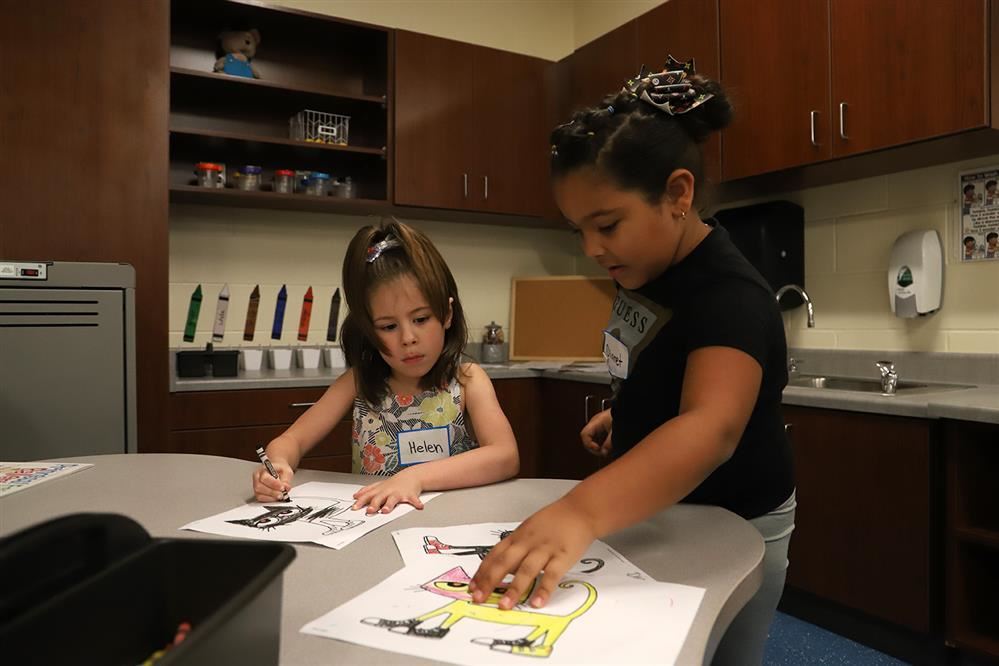- Grand Island Public Schools
- Kindergarten Ready
- Kindergarten Curriculum
Students & Families
Page Navigation

Kindergarten Curriculum
-
Your kindergarten student will gain their first introduction in science, math and English language arts curriculum areas.
English Language Arts
- Trimester One:
- Demonstrate knowledge of print concepts (i.e., a book reads front to back, left to right and top to bottom.)
- Identify the first sound in a given word (e.g., If you give the word, “fish.” The child can tell you the first sound is “/f/”.
- Identify the most common sound associated with the letters of the alphabet.
- Express ideas in writing using pictures, letter strings, labels and words.
- Trimester Two:
- When given two to three sounds in a given word (e.g., /a/ /t/) the child can blend the sounds together to tell you the whole word - at.
- When given a word that has two to three sounds (e.g., sun) the child can break the word apart into all of its individual sounds - /s/ /u/ /n/.
- Increasing recognition of regular grade-level words (e.g., cat, big, is) and irregular grade-level words (e.g., the, was, one).
- Expresses ideas in writing by stringing words together. Words are separated by spaces and there is an attempt to match consonant and vowel sounds with their appropriate spellings.
- Trimester Three:
- Demonstrates complete knowledge of blending sounds into single syllable words and breaking single syllable words apart into its individual sounds.
- Recognizes a number of grade appropriate regular and irregular words as if by sight.
- Reads emergent reader text using a conversational tone.
- Identifies characters, setting, and events in a story.
What you can do at home to help your child prepare for, and be successful in Kindergarten English Language Arts?
Visit this NDE link for reading resources.
Math
In Kindergarten, your child will learn how to:
- Write numbers from 0 to 20
- Add and subtract with numbers up to 5
- Count objects and say how many there are
- Identify and describe shapes
- Compare numbers or groups of objects and tell you which group has more or less
- Add and subtract within 10 using objects, fingers, drawings or numbers
- Understand that teen numbers are 10 and a few more
- Understand weight and length as something that they can measure
- Solve addition and subtraction problems within a story
- Trimester One:
- Number concepts through 10, sorting into two categories, identifying groups that have more or fewer, comparing length, mass, and capacity
- Trimester Two:
- Introducing the concept of equality, position language, addition and subtraction, teen numbers, identifying and sorting 3D objects
- Trimester Three:
- Number concepts through 20, identifying and sorting 2D and 3D objects, solving addition and subtraction word problems
- To prepare for first grade begin identifying coins and their values
What you can do at home to help your child prepare for, and be successful in Kindergarten math?
- For more information and ideas for home visit these Orego math curriculum links:
Science
The Kindergarten science standards and indicators help students gather, analyze and communicate evidence as they formulate answers to questions tailored to student interest and current topics that may include but are not limited to:
- Trimester One: Where do animals live and why do they live there?
- Students are expected to develop an understanding of what plants and animals (including humans) need to survive and the relationship between their needs and where they live.
- Trimester Two: What happens if you change how hard you push or pull an object?
- Students are able to apply an understanding of the effects of different strengths or different directions of pushes and pulls on the motion of an object to analyze a design solution.
- Trimester Three: What is the weather like today and how is it different from yesterday?
- Students are expected to develop an understanding of patterns and variations in local weather and the purpose of weather forecasting to prepare for, and respond to, severe weather.
What you can do at home to help your child prepare for and be successful in Kindergarten science?
- Support your child in making observations of their world and asking questions about their observations.
- I notice (see, hear, smell, feel, taste)...
- I wonder…
- Help your child identify and describe patterns in their world (winter, spring, summer, fall; color patterns made with building blocks, daily schedules)
- Take a nature walk in the same location at different times of the year
- Have your child describe changes in the motion of a toy when it is pushed with different strengths and directions (cause and effect)
- Plant a flower or vegetable garden and have your child help. Make observations of how the plants are growing, or not growing. Grass, radishes, beans, marigolds are quick and easy to grow. See what happens if they don’t get water or sunlight.
Assessments
Kindergartners take the Measures of Academic Progress (MAP) assessment three times per year. The MAP assessment is designed to assess growth in math and reading from one term to the next and obtain learning statements to identify what each student is ready to learn. The results of this assessment are also used to meet the requirements of the reading bill. Your child’s teacher will discuss their MAP assessment results with you during parent-teacher conferences.
Additionally, end of unit assessments are used to measure student mastery of skills, concepts and content in each subject area.
- Trimester One:

